Krakow
Why does everyone
want to go to Krakow?
- They say no polish town compares to Krakow for it’s beauty - It is considered one of the most beautiful cities in Europe
- It escaped miraculous the destruction of WWII
- Earliest records from 996 when a Jewish merchant referred to a trade center called krakwa
- It became the royal capital of Poland in 1038 until the capital got moved to Warsaw in 1569
- In 1241 the tsars nearly burned it to the ground – which allowed the city to Implement a harmonious street layout – originally it got built with walls which got mostly demolished in the beginning of the 19th century except a small section to the north
Krakow by Tram
Sebastion downloaded us the App for the Krakow tram system –
only problem: it only works when you are online... but it helped with part 1
today. Also at our tram station was no ticket machine, so we couldn't find a
ticket... and since we never found one we used the tram for “free” – Thanks
Krakow. At one station we found a map so we made pictures with the phone, which
helped us to navigate around Krakow.
Church of St. Joseph
As we took the tram towards downtown, we saw through the
window a cool plaza with an amazing looking church and right at the stop a
piekarnia… so we went out and Paul got it’s coffee!!
Once we had enough energy to go on it was time to check out
that cool church: Church of St. Joseph – Paul walked a little bit faster to the
entrance to avoid some of the rain….
It is a really cool looking church with the red brick and
white of the outside: it looked amazing from the street and there was so much
to discover when we got closer and also amazing inside, it is kind of a gothic
style but still color and a lot of gold and very unique side chapels.
This was really an amazing unplanned stop.
The Wawels castle:
And then we are back
on the tram to stop and walk up to the Wawels castle. Which is truly amazing.
After walking up and going inside the fortification – guess before we start
exploring we should know what we are looking at so let’s check out some of
Poland’s history:
The Polish Kingdom or Krolestwo Polskie is a little bit
more complicated:
- So Poland had a kingdom and Krakow became in 1038 the seat of the polish power: when from the Wawels castle Poland was ruled for over 500 years
- So why is it so complicated: – as where most country’s have one kingdom – Poland had a whole series of different Monarchial government – so lets start in the beginning:
- Before any royals - the slavish tribe Polanie meaning “the people of the fields” settled here in the 5th century and the Chief Piast united the scattered groups of the surrounding area in a single unit and called is Polska: that is when the 1st kingdome started:
1)
Piast
Dynasty 1025 – 1385
- 1025 the kingdom of Poland was founded (by that time nearly whole Poland was already converted to Christianity)
- Casimir III the great, reigned from 1333-70 and was one of the greatest polish kings, he extended royal protection to Jews and encouraged their immigration to Poland, because he realized that Poland needed educated people and created the institute of higher learning which became the university of Krakow
- The black death plaque Europe 1347 – 1351: but Poland was spared from the outbreak, because Casimir III decided to quarantine the border. He died in 1370 and leaving no male heir, the piast dynasty died
2)
Jagiellon
Dynasty 1385 – 1572
- Jadwiga the youngest daughter of the Hungarian king born in 1373 came in 1384 to Poland and was coronated as “king” of Poland. The Polish refused to let her marry the 14 year old William from Habsburg (they thought he was too young) even both parents wanted them to be married and the marriage to be consummated before her 12th birthday
- Lithuanian Grand Duke Jogaila married her in 1385 (by the way no-one knows when he was born, likely in 1352) – officially they co-ruled the country (yeah, like we believe that!)
- Jadwiga got pregnant in 1398 – her daughter died after 3 weeks and she soon later and is buried in the Wawels cathedral ( we saw her sarcophagi)
- He was king over both Poland and Lithauen, when he died in 1434 he left Poland to his eldest son Wladyslaw III (10 at the time) and his younger son Casimir (7 at the time) got Litauen
Exploring the Castle:
The Fortification: we enter this nice white/red brick looking
castle through the Arms gate (not difficult to guess why it is named like this,
because you see a lot of coats of arms on it) and then you enter right into
the:
Wawel Cathedral of
Saints Stanislwa and Waclaw
- It’s one of the most important churches in Poland – heew the monarch got coronated also in here you find a lot of tombs of the polish kings as well as other nation heroes and poets (but we did skip the crypt – we saw enough upstairs)
- Named after Stansilaus – he was the bishop of Krakow and canonized in 1253 and is today the patron of saint of Poland
- The pre-historic bones at the entrance are to believed to have magical powers and as long as they are here the cathedral will remain (and yes we saw the bone hanging above us too… kind of weird) – guess it worked until today
There was a lot to see and most of the time we didn’t exactly
know what we were looking at, but the whole cathedral is kind of overwhelming.
One thing I remember is a huge kind of golden sarcophagi in the middle of the
Chapel: the Shrine of Stanislaus, that is really an imposing one. By the way
there are guards everywhere to make sure all is safe, you don’t touch anything
and no-one takes a picture.
We came by a lot of important side chapels and saw tour
groups standing around some of the tombs: that’s when we realized about the
important royals to be married here and we stood in front of Jagwiga
sarcophagi.
Back outside we looked back and up towards the church: a lot
of different style towers, roofs… it is kind of cool how it looks like: one
stands out it is a golden looking dome: the Sigismund Chapel (I ‘m sure we saw
it from the inside – even I’m not quite sure anymore which one it was)
In the courtyard
Paul decided sitting and enjoying is wonderful – Gine thought
walking around and seeing a lot is enjoying it is even better… and so Gine
walked around to check it all out – only so that Paul had to walk around later
and see it all. One of the things we discovered right away are some ruins in
the middle of the grassy area…
exploring a little bit more of the castle, we also had an amazing view
on the Vistula River and from up here we could see a dragon throwing fire… no
question we have to go to the Dragon…
the dragon of Krakow: through
another gate, down some stairs and then we are in front of the dragon… we did
had to wait in the rain a while until it finally decided to throw some more
flames…. And then we had to walk around
nearly the whole castle – ok so we had a view on in from all sides and then we
were heading up:
Ulica Kanoniscza: as the first downtown street and
starting right across the castle we walked along the oldest street and admired
the gorgeous houses lining it: it is nearly unbelievable that a lot of them are
from the middle ages, rebuilt with renaissance, baroque and neo-classical – at
one of the houses you can see a picture of Pope John II – it is because he
actually lived here during the 1960s. And wondering where they name of the
streets comes from: once upon a time they had here cannons!!
Ulica Grodzka
Turning into the Ulica Grodzka another amazing street with
more awesome houses (by the way: those amazing houses along pretty streets are
everywhere…. regardless where you are) And it was a lot of fun to walk along on
the way to the market place. Besides the rain we had 3 highlights along the
street:
Coffee: we are on
the go nearly half a day… so yes we do need a coffee!! and you should have one
if you are at a coffee place – especially when we need to warm up and being out
of the rain
Church of St. Peter
and Paul – Kosciol sw.sw. Piotra I Pawla
- Built in 1596 it is one of the most beautiful early baroque churches in Poland
- On the railing in front of the church you can see the 12 apostles – they are there since 1715
It looks old from the outside, inside it is white black and
gold – so it is baroque but not the overwhelming style with gold everywhere – I
liked it a lot. And it had a crypt where we could go down… you nearly can get
lost down there in the endless corridors and rooms with a few large sarcophages
(at least I nearly lost Paul), but then the names don’t tell me anything….
right near it is the
St. Andrews church –
Kosciol sw Andrejzeva
From the 13th century, this church looks like she
would require some repairs and from the outside you think it would be plain and
for sure not baroque and you go inside and you don’t know where to look first,
also they had a lot of little cards of saints and the Madonna to take with you
all with gold glitters on them…. This surely is not what you expect.
Main Market Square: Rynek
Glowney
The rest of the afternoon we spend with a few raindrops and
a lot of clouds around the market square. I have to say I love Krakow and if
the sun would be shining we could spend hours and hours around this old town –
sit and look – walk around, have a coffee or ice cream and admire the houses
and soak in the atmosphere, but we could still let it sink in a little bit. By
the way it is Europe’s largest medival town square from 1257 and in the middle
of it is this huge building the:
Cloth Hall = Sukiennice:
- from 1875 after it replaced the burned down hall from the 1300s
- it was once the center of krakows medival clothing trade from the 14th century, when a roof was put over the 2 rows of stalls, it was extended in a 108 m long gothic structure
today you are not buying
cloth, but it is a lot of fun: you walk in and see a lot of coat’s of arms –
have the old medival feeling and each stand in there in the old wooden
structure is a souvenir shop… so no problem you can find something here (I
should have come without Paul – he was not into souvenir shopping đŸ˜Š)
Coming out of the Cloth hall you stand in front of the:
City Hall Tower – Wieza Ratuszowa : a nice gothic tower the only remaining part of the former city hall
– we looked up hoping not to get too much rain on us… in another corner we discovered the
St.Wojciech church – Kosciol Swietego
Wojciecha: it is a small tiny chapel
(upps they say it’s a church) in one of the corners of the marketplace.
St. Mary’s Basilica: Kosciol Mariacki
- Built as a rival to the royal cathedral on the Wawel Hill from 1355 until the 15th century
- Hejnal Tower: the famous trumpet call is hourly – the Heinjal call is unfinished in memory of a medival trumpeter shot while sounding the alarm
At the other end of the market
place is this huge brick church with it’s 2 towers looking down on the
marketplace… what I liked a lot is the cute houses near it – the horse
carriages in front. It’s raining so that is another good time to go inside
which was a little bit disappointing: because you have to pay to go in – if you
go around the corner you can go in for free – but they don’t want you to look.
Guess that’s what you call a tourist attraction. But we still had a nice view
up on the blue star ceiling and a glance into the huge church. Yes I do think
it would be worth to go in and have some more time… but then we did not have
enough time for Krakow in the first place. This is a city I would like to come
back again.
Florian Gate – Ulica
Florianska:
Getting cold and wet and it’s early evening we decided to
head back and get warm – since we will have more busy days ahead of us so
heading up towards the Florian gate – I don’t think we felt to be part of a
royal route… but this street was so cool because looking up you saw the gate in
the back with the amazing houses lining it – if you turned around you saw the
red brick church tower in the back with the amazing houses along the streets –
I don’t know which view I liked better… it was cool. After passing the gate we
came to the:
Barbican:
- is one of the remaining parts of the medieval fortifications – a double ring which ones surrounded the city built in stages since 1285, most was pulled down in the 19th century,
- a Barbican is an outer defense post to a city or a castle, built in 1498 – this one protected the Florian Gate which was connected to an underground passage
it kind of looked super cool standing there. And right near it was a huge
picture frame with a guy sitting in it: Jan Matejko – since I’m not an art
lover I didn’t know the name… but I do like his picture frame. And then we
stand on the:
Plac Matejki – Pomnik Grunwaldzki
They say it is a typical Krakow square… we went to check it
out because we saw the huge monument (= pomnik).
- Unveiled in 1910 even Poland did not exist on the map at this time – since it was divided
- It was unveiled for the 500th anniversary of the victory over the teutonic knights in June 1410 (by the way: the Teutonic Order was formed by the German knights in 1190 on the cruisades – they even had once a state of the teutonic knights – this mercenary army invaded a lot of North East Europe to Christianise it)
- The figure on top is King Wladyslaw Jagielto (he was the one winning the war) and you can see the dying Grand Master of the Teutonic Order Ulrich von Jungingen
Riding through old
houses in an old tram
And we hop again on the tram and head back… there is always a lot to see.
piekarnia
there is one really interesting thing about going to a
bakery: you always pay per gram you are bying. You see a cake and it says: 29
PLN per kg: then you tell them how big a piece you want and it goes on the
scale.
And as where the other day we thought we get a chocolate
cheesecake – but it was a plum cheesecake... today we had a cherry
cheesecake... when it looked like chocolate. Guess our polish is still not that
great.

 Kraków, Lesser Poland Voivodeship, Poland
Kraków, Lesser Poland Voivodeship, Poland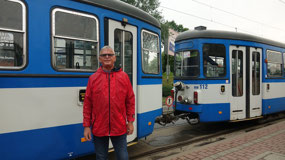
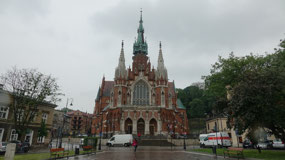
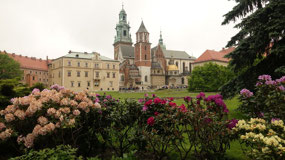
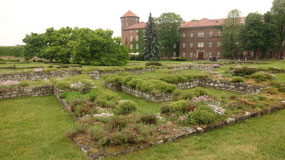
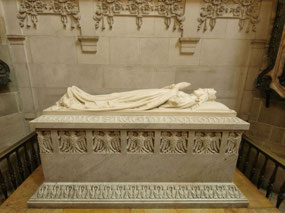
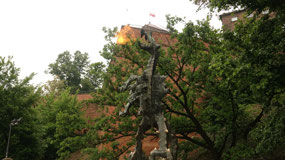
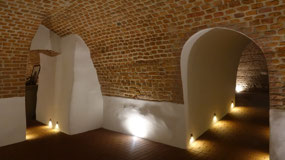
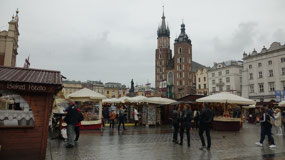

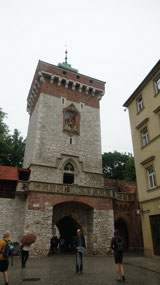
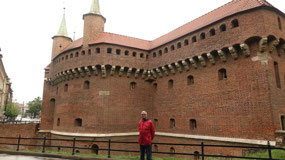




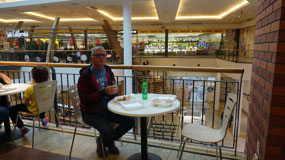
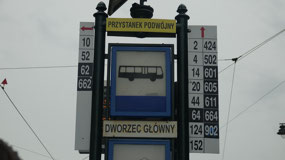
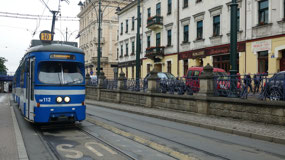
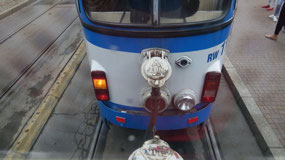

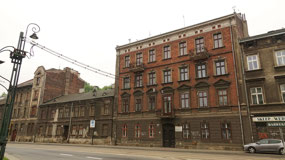
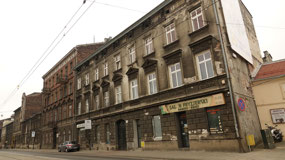
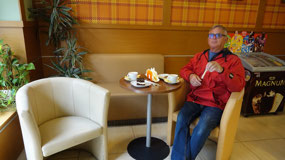
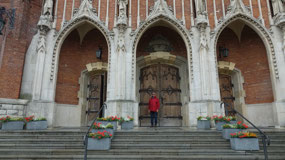
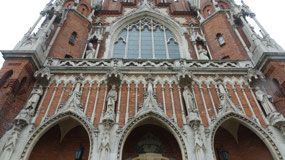
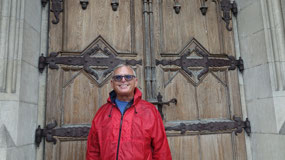
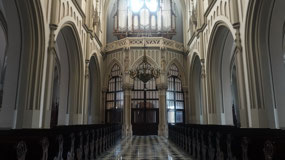
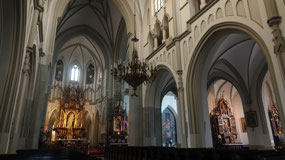
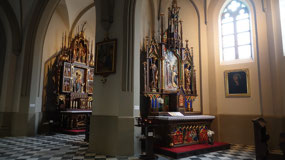
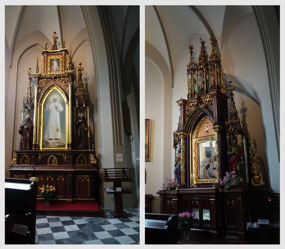

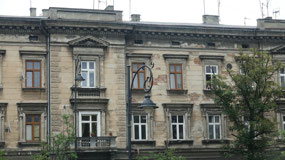
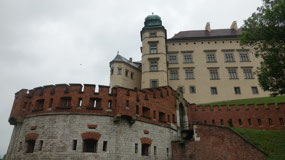
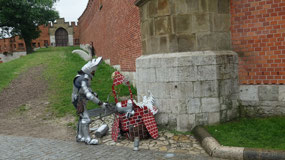
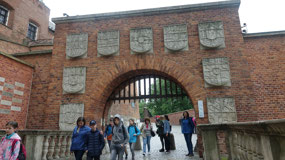
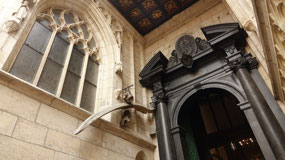
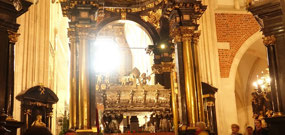
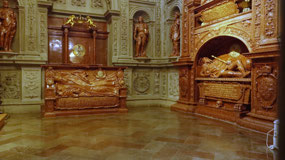
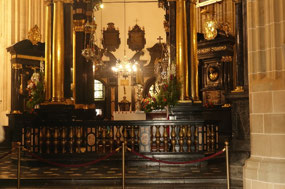


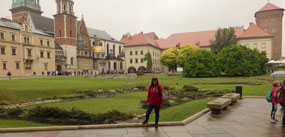
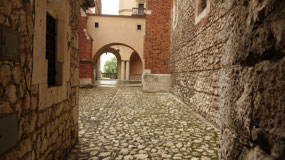

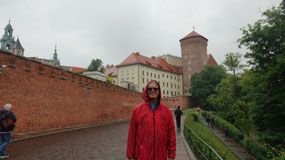
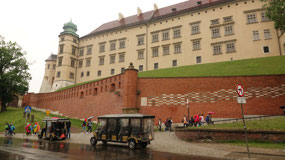
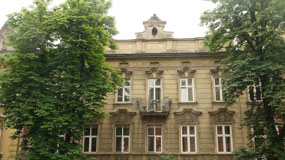
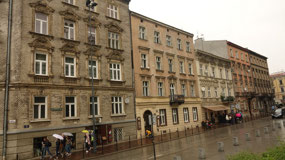
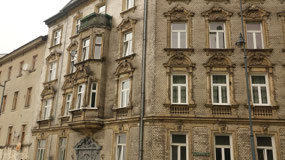
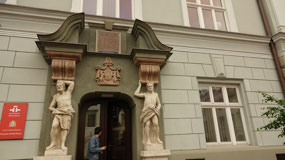
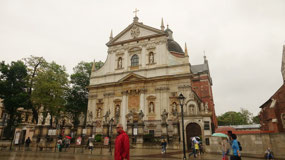
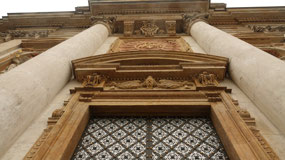
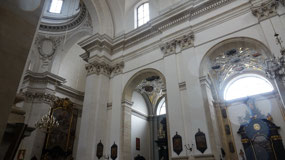
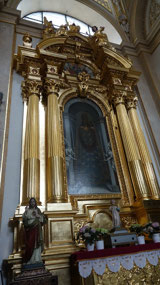
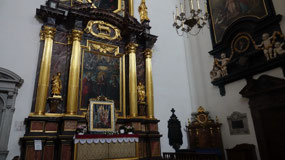
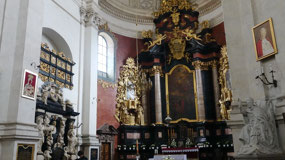
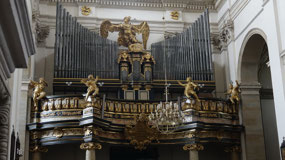
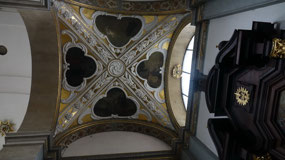
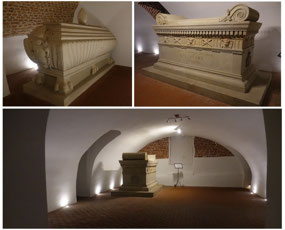
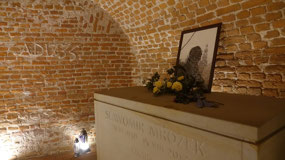
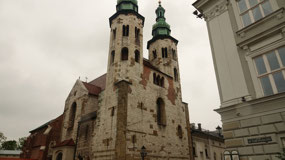
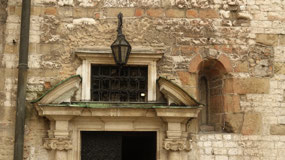
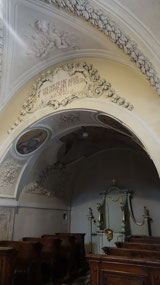
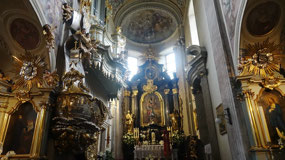
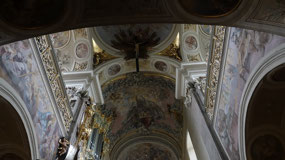
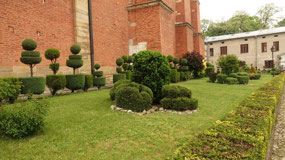
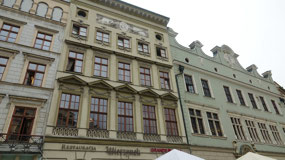
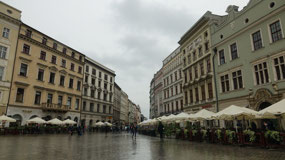
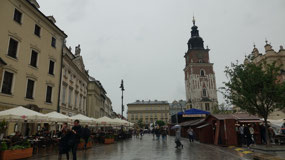
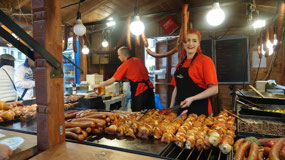
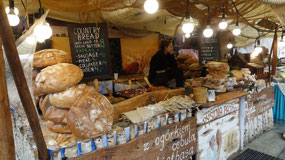
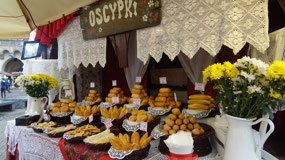
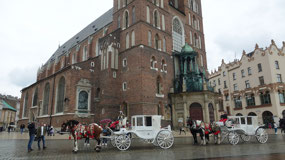
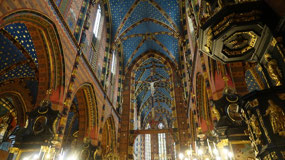
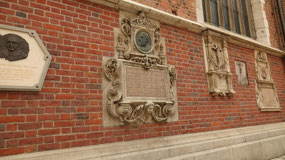
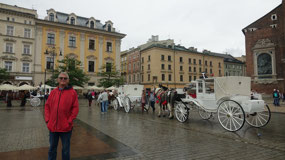
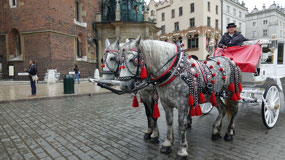
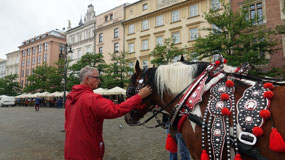
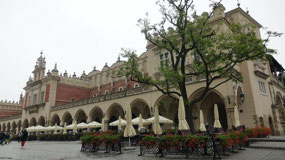

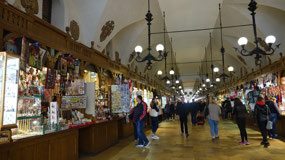

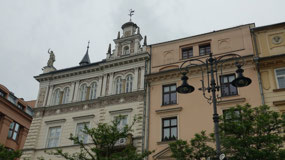
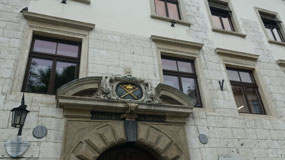
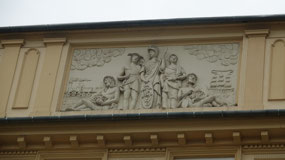
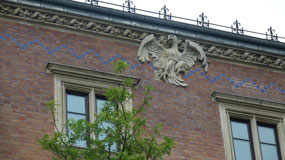
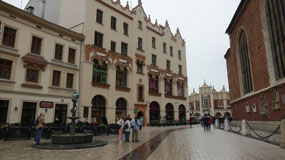
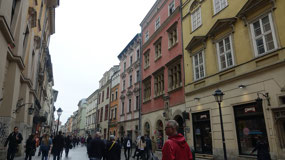
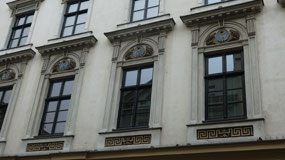
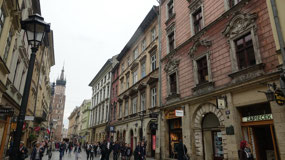
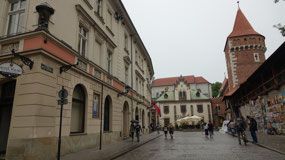

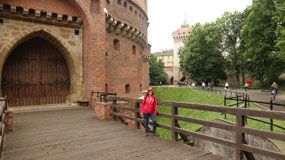
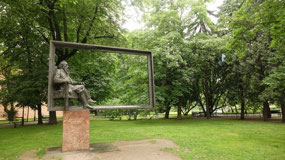
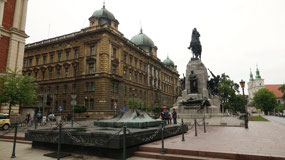
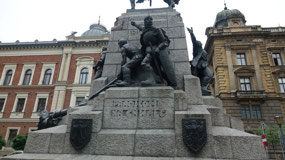
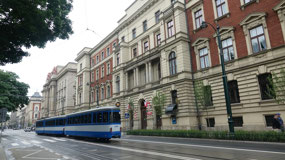
2025-05-23